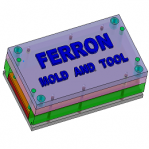
Rich Taft from CNC Software
CNC Software-
Posts
261 -
Joined
-
Last visited
Recent Profile Visitors
Rich Taft from CNC Software's Achievements
-
JCDFCM, IMO, that legacy style text import really needs to be replaced. I really can't recommend using the old text for exporting data because it would be lossy. You would be far better off exporting XML from your VB.NET objects. We have an improved API for the tool system on the way that will be available in the next major release of Mastercam. We are also working on some new text-based import / export functionality. I don't have a firm release date for that but once the new import / export format is ready we will be phasing out the old one. In the mean time I wouldn't recommend doing any new development around the old text format.
-
X8 custom tool profiles from X6
Rich Taft from CNC Software replied to Zoober's topic in Industrial Forum
Hi Zoober, It is not necessary to convert all of your custom tool profiles to DXF format. That would be a ton of work. The original vertical profile in your MCX-6 file is still perfectly valid going forward but you did uncover a defect that appears to have gone unreported until now. I just went back into X6 and created a custom tool profile and saved it to an MCX-6 file. I then created a TOOLDB library and a TOOLS-6 library with a custom tool (pointing to the same MCX-6 file) for testing. I ran migration using X8 and examined the result of both files. I found that the 'scalable' option came in turned on from the TOOLS-6 file but it was OFF when importing the TOOLDB file. Obviously that is not a good thing. I logged this as R-02596. It looks like this defect would only apply to users who created TOOLDB files in X6 and imported them into X8 using the migration wizard. The TOOLS-6 result looks correct. I think that may be why it went unreported for so long. The quick work-around for a single tool would be to turn off the "Scalable" checkbox and re-import the MCX profile in the X8 edit tool dialog. That seems to give me the correct tool without redrawing anything. I am going to look into a better workaround that would fix this at the library level but I'll need to test my theory. If you want to send your library to my attention at [email protected] I would be happy to take a look. -
X8 GIANT tool holders from X6?
Rich Taft from CNC Software replied to Joe788's topic in Industrial Forum
When you run the migration utility it converts the .HOLDERS file to a TOOLDB using the units you have actively selected in Mastercam. Mixing inch and metric tool components in the same assembly isn't supported yet but I entered an enhancement request (D-15558). If you change your Mastercam units back to inch and run the migration wizard on the holder files again you will get .TOOLDB's with those holders in inch units. That will keep the giant holder at bay for now. I would rename the ones you already converted to <my holder name-mm>.tooldb first in case you need to use the metric version for a different job. -
Mastercam X8 Public Beta 1
Rich Taft from CNC Software replied to Chris Bell CNC Software's topic in Industrial Forum
A backup of the original was created prior to updating it to X8. If you rename the backup from *.tooldbX7v14 to *.tooldb and you'll be able to use it in X7. -
tool number and dia. offset number
Rich Taft from CNC Software replied to goldhntr's topic in Industrial Forum
There are several ways to change the offsets for an operation (i.e. edit common parameters, edit box in the toolpath parameters page, clicking on the tool in op manager etc.) I did some testing and I found that if I edit the offsets by clicking on the tool in the operation manager the offsets didn't update without a regen. If I change the offsets in the operation parameters it worked fine. That may explain why it's working for one person and not for another. I will test all the different workflows I can think of and enter a defect so we can take a look. -
Thank you for the clarification. I'll give that a try.
-
I took a minute to review the original defect and re-test on a clean X7-MU2 install. I created a simple contour operation and copied it after itself using drag and drop in the toolpath manager. I then edited the second operation by clicking on the parameters. From the tool page I right clicked on the tool and selected 'Edit'. I changed the diameter and exited the dialog using the green check button. Upon exiting a message box appeared warning me that the tool was used in more than one operation. This message box provided the following options: Update tool and all operations that use this tool (default) Create a new tool Cancel tool changes Selecting the first option updated both operations (still using the same tool with the new diameter) and marked both operations dirty. Selecting the second option added a new tool and updated the operation I was editing without affecting the original operation. The third option returned me to the tool parameters page without updating the tool or marking anything dirty. For good measure I made sure the ESC key and the red 'X' in the upper right hand corner of the message box behaved exactly the same as selecting the cancel option. Everything seems to be working as expected when I start from a new file. If you're using an existing file double check to make sure the operations are still using the same tool.
-
lolly pop cutter not undercutting in x7 mu2
Rich Taft from CNC Software replied to jerod951's topic in Industrial Forum
The fix for the corner radius parameter was done in X8 and X7-MU2. If the tool was defined prior to the fix, you'll need to re-enter the diameter in the edit tool dialog. Once you do that the radius field (which should be a calculated field) will be updated to 0.5D. The value will only get updated when you set the diameter in a new tool definition or edit the diameter of an existing tool. In order to qualify as an 'edit' operation the number will have to be changed. If you just enter the same value and hit enter the dialog doesn't see the field as being different and the udpate won't happen. To get around this, just make note of the original diameter, set it to something else (and press enter) and then set it back to the desired value. Don't forget to update the original library tool(s) like Mark did so you don't run into the same issue on a future job. I hope this helps. -
Tool manager - manufacturing names update???
Rich Taft from CNC Software replied to gms1's topic in Industrial Forum
It's on the list. -
Tool manager - manufacturing names update???
Rich Taft from CNC Software replied to gms1's topic in Industrial Forum
You can still save MCX-n files and draw the tool profile in the first quadrant in Mastercam the same way you have always done. If you're drawing the tool in Mastercam it might be easier to save it to the library while you are there since the stand-alone tool manager doesn't have sketcher functionality at this point. If you save your tool to MCX or a level the standard Mastercam rules apply. If you prefer to save them as DXF files you will need to draw the profile a little differently. The DXF file must contain a level named "CUT" (without the quotes). This is where you draw the cutting section of the tool The DXF file must contain a level named "NOCUT" (without the quotes). This is where you draw the non-cutting section of the tool The geometry that defines the CUT and NOCUT levels must consist of a closed boundary. The tool must be oriented horizontally in the 1st and 2nd quadrants The origin is typically placed so that the Y-Axis intersects the NOCUT geometry at the point where the face of the holder would typically be. *I believe that is part of the standard but it's not currently used in Mastercam. I can send you a sample DXF that demonstrates this if that helps. FWIW, the profiles you already created would probably be fine if you saved them out to MCX-7 and added them to the library from Mastercam. The stand-alone Tool Manager is more suited for library management than custom tool creation at this point -unless you have files from the Manufacturer. I'm guessing if the Tool Manager had a simple sketcher that would probably make life easier. I'll talk to the tech writers to see if we can expand on this topic in the help system. -
Tool manager - manufacturing names update???
Rich Taft from CNC Software replied to gms1's topic in Industrial Forum
Yes, there are plans to allow users to customize the list. Unfortunately we didn't get to it for X7. I'd be interested to know more about how you are using this field but we can take that offline if you want to PM me. I might be able to suggest an alternative. -
Tool manager - manufacturing names update???
Rich Taft from CNC Software replied to gms1's topic in Industrial Forum
The ISO13399 specification is not something that you need (or want) to buy. You really don’t need to understand the standard, you just need to know whether or not your tool supplier has files available in that format. It’s no different than exchanging CAD data with another shop. You might tell them that you can send them an Mastercam X7 file. They would not need to know anything about the file format itself, they just need to know whether or not they have the ability to import it. Can you tell me specifically where your running into problems? Maybe we could run some tests with your files if they're not coming in correctly. -
Converting tool libraries to X7 from X6
Rich Taft from CNC Software replied to RSELLINGR's topic in Industrial Forum
Rob, It looks like your Mike at Prism reported this to QC this week. Here is the defect id for tracking purposes: D-08966: Tool Material changed to Carbide; Was HSS if it was from earlier version -
What am I doing wrong? Tool Manager X7 MU1
Rich Taft from CNC Software replied to gms1's topic in Industrial Forum
I tested dragging and dropping holders from one database to another in X7-MU1 and it worked okay for me. I am in the habit of making sure I've explicitly selected the item I want to drag by clicking on it first rather than doing it in one motion so I'm wondering if that has anything to do with it. I tried dropping the holder into the 'document' and onto the holders branch of the tree in the database explorer and both seemed to work okay. I doubt the database is going to be a problem but I'd be happy to take a look at your file if you want to send it over.
Join us!
eMastercam - your online source for all things Mastercam.
Together, we are the strongest Mastercam community on the web with over 56,000 members, and our online store offers a wide selection of training materials for all applications and skill levels.






